Peninsula Valdes and the Pampas
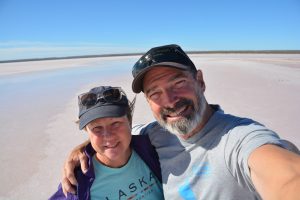
Julie and I standing at the sunken salt flats on Peninsula Valdes which is an amazing 35 metres below sea level
Our guidebook called Peninsula Valdes on Argentina’s mid-Atlantic coast “…one of the world’s great nature preserves.” We’ve learned guide books are sometimes prone to hyperbole but we couldn’t pass up this gem on our drive up National Route 3 towards Buenos Aires. And the promise of seeing animals we had rarely or never seen before made the opportunity a must do. That is how we found ourselves camped in the small out-of-season town of Puerto Piramides with the promise of a great day of discovery ahead of us.

The open coastline of Peninsula Valdes – we couldn’t get enough of the colour green after so long without it
Peninsula Valdes, a UNESCO World Heritage designated area, is shaped like half a giant hour glass turned on its side. You drive through the narrow neck of the hour glass and the peninsula then opens up into this vast flat open plain lined with stunning cliff and beach coastlines. For reasons beyond us this unique geological feature also attracted a unique range of creatures and showcased them for all to see.
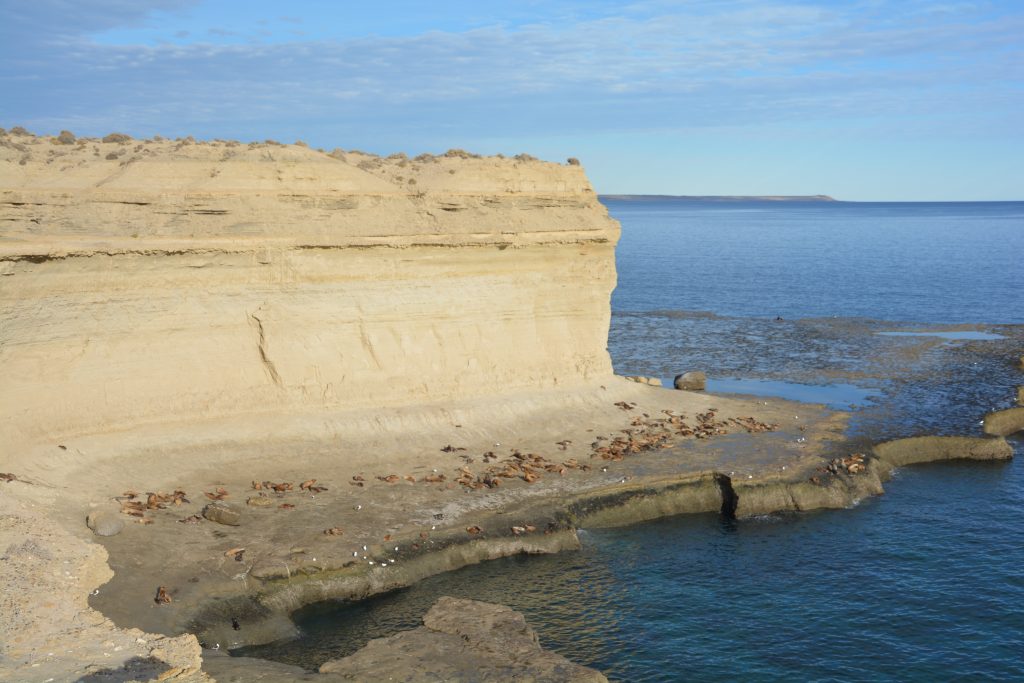
The white cliffs of Peninsula Valdes featuring hundreds of lazy sea lions enjoying the afternoon sun
We explored part of that coastline near this little town and saw hundreds of sea lions lolling about on a rock ledge of a sandstone cliff and a few Magallanic penguins swimming about the cold waters. The roads of this peninsula are all well maintained gravel and we made good time out to Punta Norte where one of the animal kingdom’s most amazing scenes takes place. It is on this peninsula, and nowhere else in the world, that Orca killer whales intentionally beach themselves on the steep gravelly beaches in their hunt for penguins and baby sea lions.
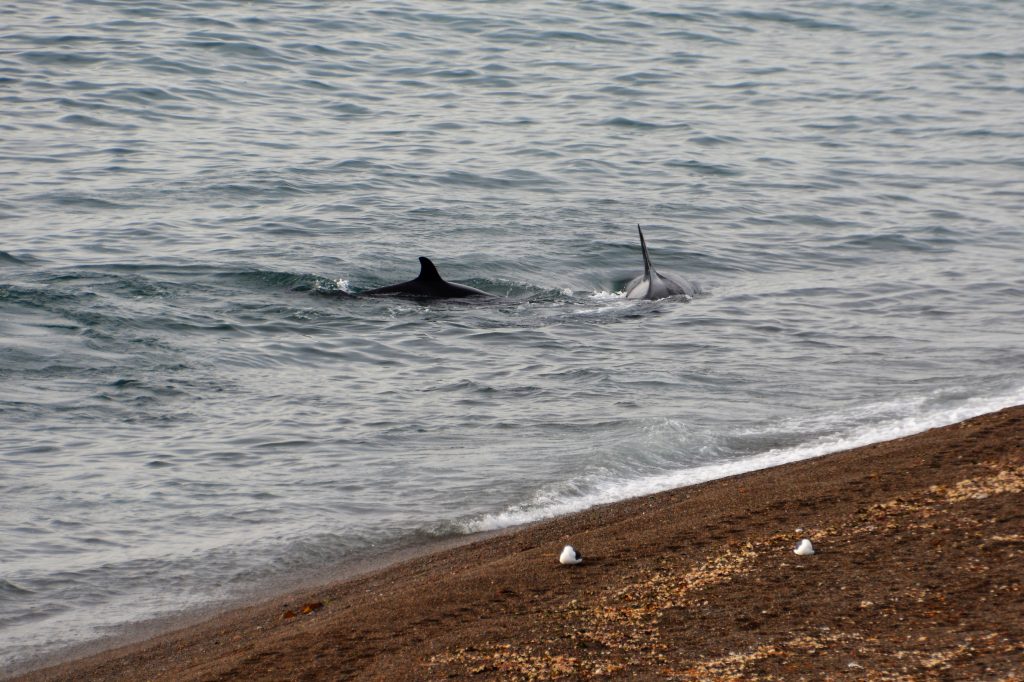
A couple of hungry orcas prowling very close to the beach, hoping for an unsuspecting penguin or sea lion
We stood on the bluff above this famous beach at high tide and watched the orcas, which are actually part of the dolphin family, circle along the beach while the sea lions and the penguins cannily stayed well above the water level. When the orcas moved offshore the sea lions cheekily went in the water but when the orcas came inshore everyone else moved to higher ground. So we never saw the orcas self-beach in pursuit of prey but our cheering for the sea lions and penguins paid off and they survived the day.
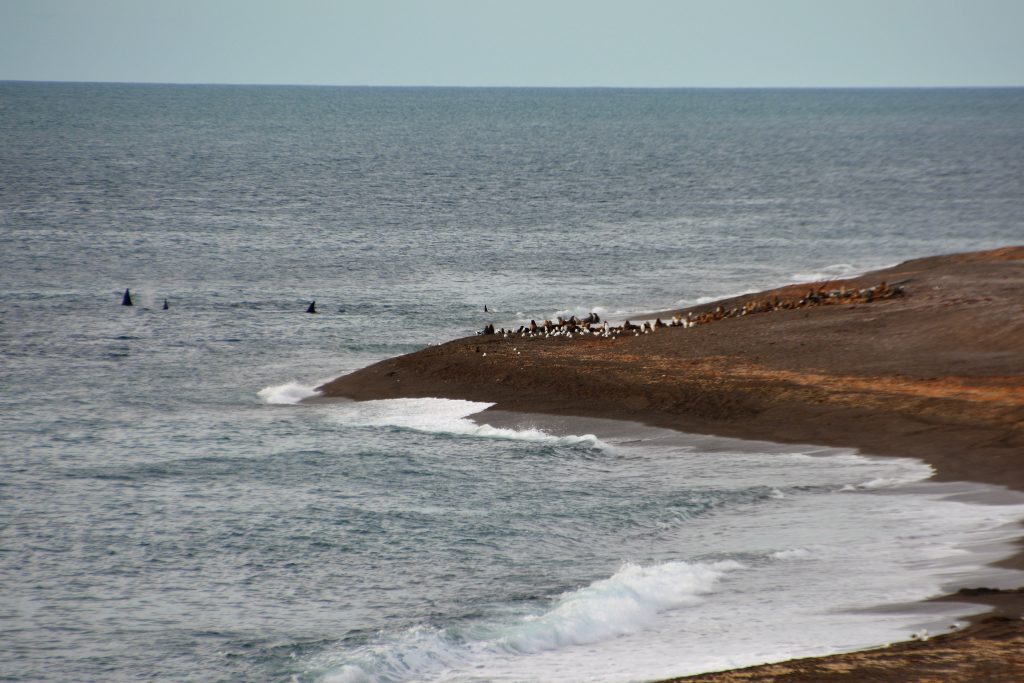
The animal world in action – orcas patrolling off the steep grainy beach while sea lions stay above and out of their reach
Further up the coast we saw more Magellanic penguins, a breed we had never seen before, and the huge elephant seals. These massive creatures, much bigger than sea lions, seem to have their own beach and mothers and their babies were basking in the cool sunshine. Mature males can grow to an incredible 4,000 kilos (almost 9,000 pounds) and have a huge bulbous nose that looks almost cartoonish. We also saw the hairy armadillo, including up close sniffing Julie’s shoes while we were enjoying our picnic lunch. Another strange creature we’ve never seen before.
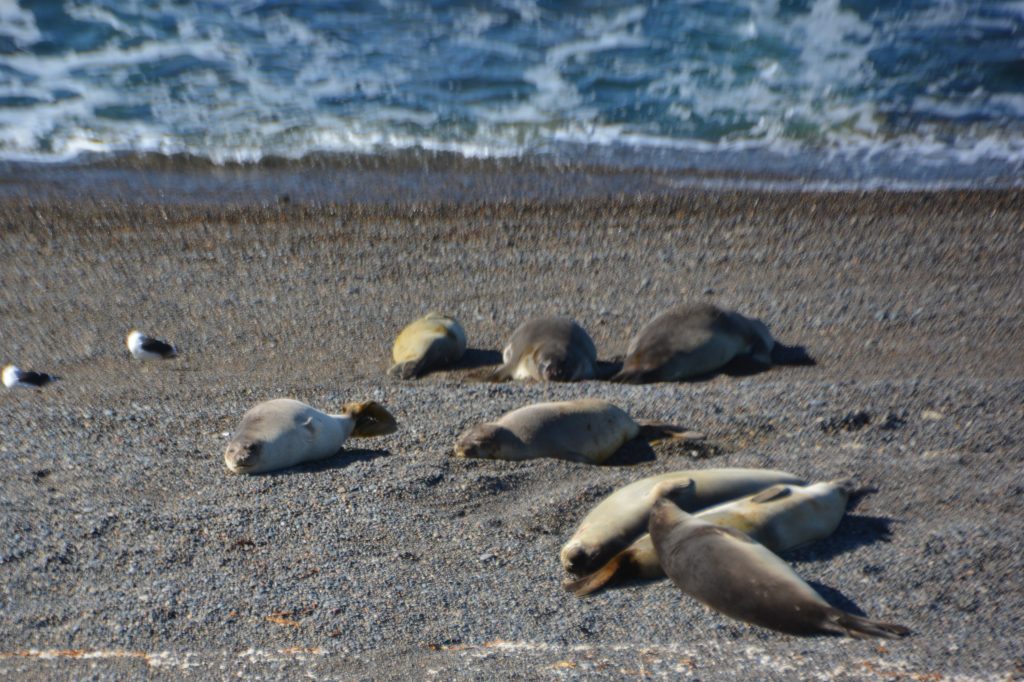
Female and juvenile elephant seals, larger than sea lions and owning this long gravelly beach, spend a quiet day in the sunshine
After a fabulous day exploring the park and more than 240 kilometres on dirt roads, we were about to exit the scene when a pair of Patagonian cavies ran across the road and then posed for us. A cavy is the size of a dog, the head and ears of a rabbit and the gait of a deer. It is an illusional animal – at various times you think you are looking at one animal, only for it to move or show a different side and become something else. Full points to the cavy.
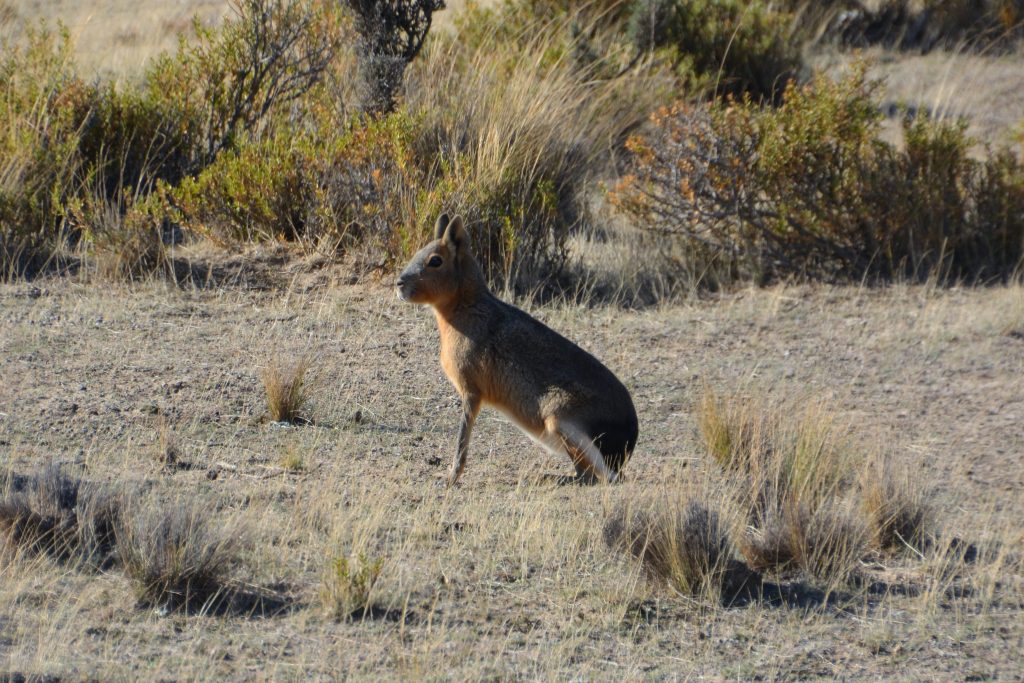
A Patagonian cavy, a strange creature with features from different animals, was happy to pose for us after crossing the road
We camped behind a small hill on the highway that night and the next day continued our relentless and endless quest northward. Amazingly we were still only halfway between Ushuaia, which we left six days before, and Buenos Aires.
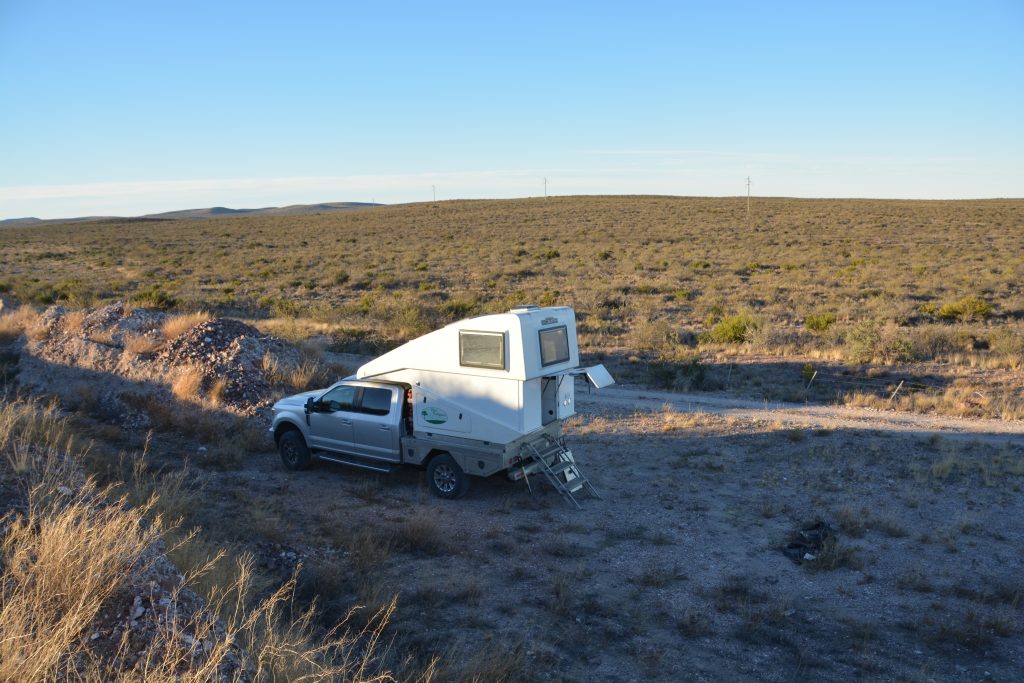
A small hill next to the road in the middle of endless flatness was a good place to camp for us to be sheltered from the road for the night
As we moved north the small groups of guanaco feeding on the sides of the road that we had enjoyed so much finally disappeared and the flat scrubby bush land thinned out, replaced by more open grass. We crossed two major rivers and finally left Patagonia, entering the region known as the Pampas. The Pampas is renowned as Argentina’s cattle country, home to the famous gauchos and origin of the country’s love for eating meat.
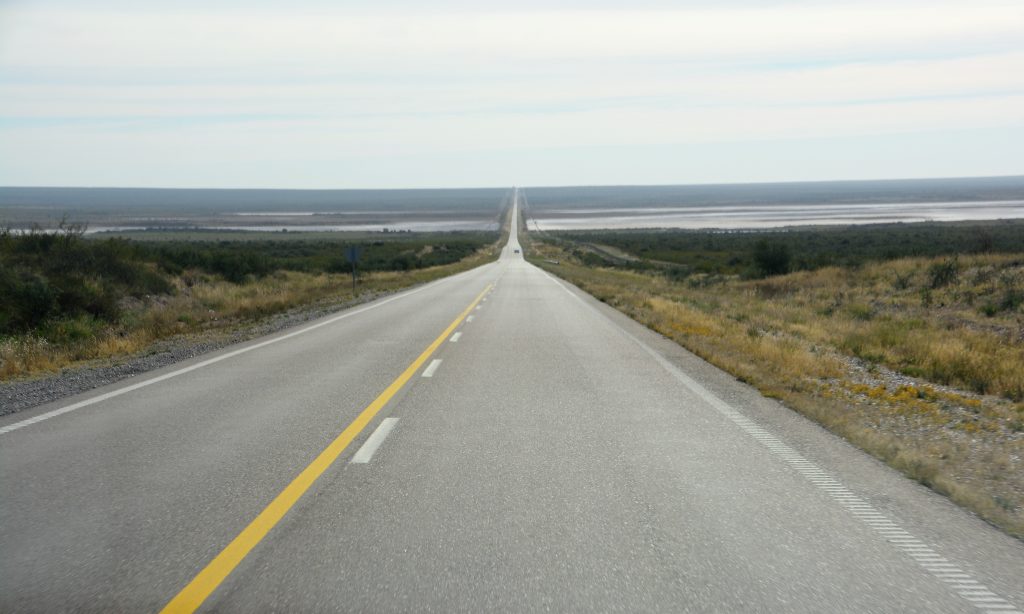
The roads were high quality and salt lakes occasionally appeared on the horizon but the long straight road just kept giving
And we saw the immediate difference – flat open plains of healthy golden grass, fat cattle grazing, a few crops of hay and grain being grown. At this latitude obviously the weather is better, the soils are better and perhaps the rain more reliable. In any case, it appears we’d left the harsh semi-arid Patagonian steppe, which we spent the last two or three weeks travelling through, well behind.
After seven consecutive nights of free camping in the bush we treated ourselves to a hotel in the coastal town of Bahia Blanca and enjoyed the evening wandering amongst the downtown area searching for a restaurant and watching the locals at play. All good fun.
We were looking forward to driving across the famous Pampas on our final leg to Buenos Aires, the endless fertile plains, high grasses, herds of cattle, sprawling estancias and gauchos in traditional dress riding their beautiful horses. It didn’t quite work out that way.
Perhaps we weren’t far enough west to see the ‘real’ Pampas or maybe just had the wrong expectations. We did see many herds of cattle and one gaucho riding his horse with traditional baggy pants and smart-looking beret but for the greater part of the day we saw agricultural fields, crops now dormant with the impending winter, ploughed fields waiting for spring, fields lying barren after the recent harvest. It could have been the mid-west of the US or the plains of Canada but it was what we saw of the Pampas in Argentina.
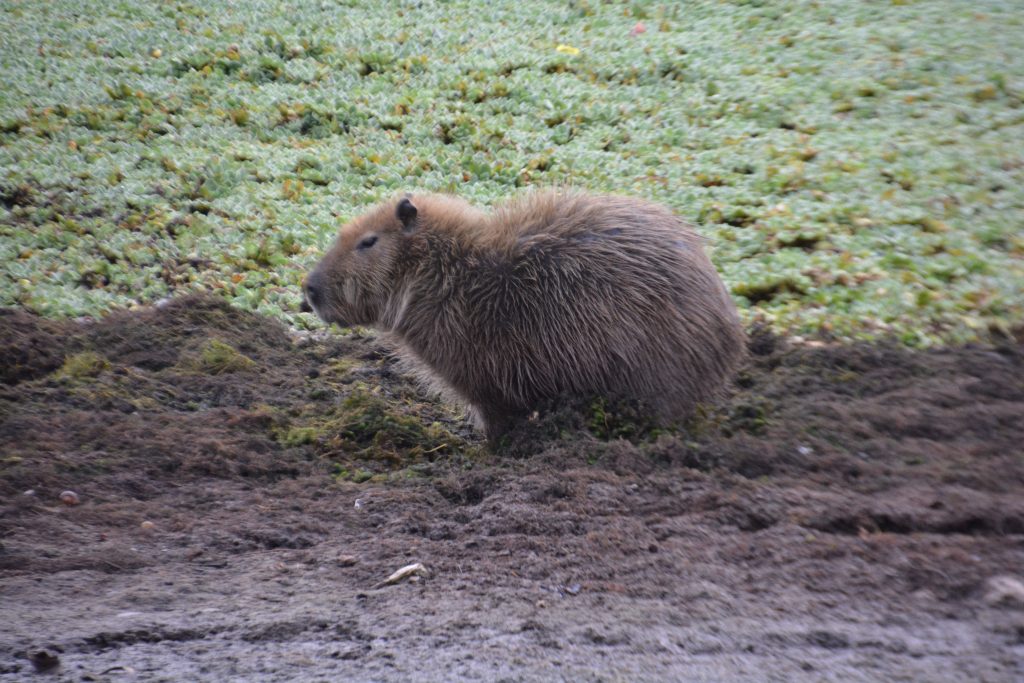
Of course you knew this is a capybara – the largest rodent in the world – living on the banks of a lake near where we camped. They can get up to 130 pounds (60 kilos). Also called a carpincho in Argentina.
Our last day in Argentina was a grey, drizzly, soggy day, the rivers high and the fields flooded. Strangely, as we approached the country’s thriving capital Buenos Aires the roads deteriorated and our pace slowed. We followed the outer ring road north of the city, crossed the magnificent bridge spanning Rio Uruguay and within 20 minutes had passed into our last South American country, Uruguay. We camped that night on the banks of the river within the grounds of the border town’s famous, if you can call it that, meat processing plant, a UNESCO World Heritage location.
We thoroughly enjoyed our time in Argentina, the remoteness of Patagonia, the beauty of the national parks, the reunion with Ushuaia, the warm people and rich culture. We regretted not spending more time here but were fortunate that we had been to Buenos Aires before and decided to use that time exploring Uruguay instead. Argentina, hasta la vista!











Comments
Peninsula Valdes and the Pampas — No Comments
HTML tags allowed in your comment: <a href="" title=""> <abbr title=""> <acronym title=""> <b> <blockquote cite=""> <cite> <code> <del datetime=""> <em> <i> <q cite=""> <s> <strike> <strong>